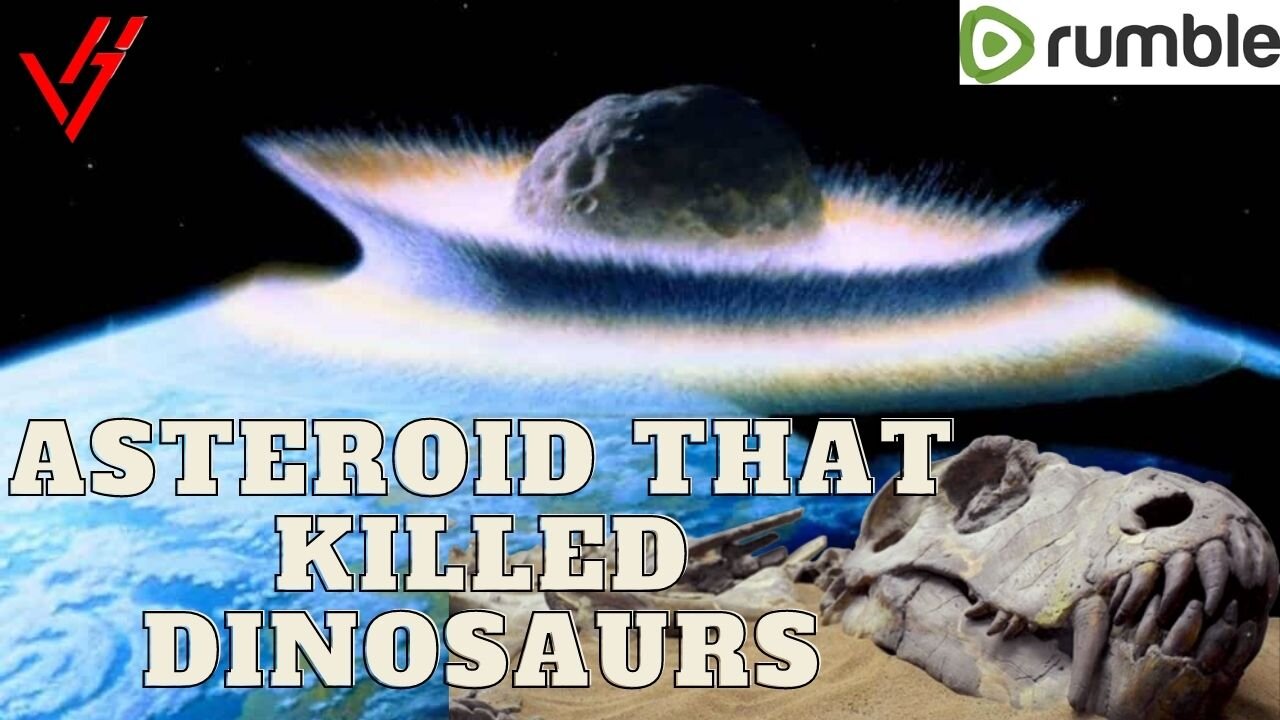Premium Only Content

Dinosaur-killing asteroid most likely struck in spring
00:00 - Dinosaur-killing asteroid most likely struck in spring
00:06 - 1 - Life on Earth:
The impact that ended the age of dinosaurs some 66 million years ago was the worst single day that life on Earth has ever endured. A six-mile-wide asteroid called Chicxulub slammed into the waters off what is now Mexico, triggering a mass extinction that killed off more than 75 percent of Earth’s species.
Unfathomably powerful earthquakes rattled and rolled the planet’s crust. Tsunamis more than 150 feet tall pummeled North America’s shores. Wildfires ignited hundreds to thousands of miles away from the impact site, set ablaze by the searing heat of the asteroid’s initial impact plume and the torrents of debris that followed.
Hundreds of sites around the world preserve vestiges of this cataclysm—but at one unusual site in North Dakota, fossil fish that seem to have died within an hour of the impact hold a crucial piece of information: Life on Earth suffered this devastating blow on a fateful spring day.
The growth patterns in the fish’s fossilized bones, described in a new study published in Nature, suggest that they perished just as their growth was speeding up from an abundance of food, consistent with death during springtime. The new findings also add to growing evidence that the Chicxulub impact was a worst-case scenario.
After the initial calamity, life on Earth faced a horrifying “nuclear winter” that persisted for months to years after the impact, the phase of the extinction event that claimed the most species. Gasses and particles were flung high into the atmosphere and blotted out the sun, causing temperatures to plummet by more than 60 degrees Fahrenheit and cutting the Mesozoic’s ecosystems down at the knees.
But if the asteroid truly struck in the Northern Hemisphere’s springtime, many creatures there didn’t live long enough to face this global darkness: During spring, most of the hemisphere’s flora and fauna would have been out looking for food and mates. Meanwhile, Southern Hemisphere animals would have been preparing to hunker down for fall and winter, possibly giving them a slight edge in the initial phase of the catastrophe.
02:09 - 2 - How will it be after impact:
“If you don't survive the impact, you don't even have a fighting chance in the nuclear winter,” says lead study author Melanie During, a Ph.D. candidate at Uppsala University in Sweden. “I don’t think you could have picked a worse season.”
02:25 - 3 - Fish frozen in time:
The study is the latest to examine the exquisite fossils at North Dakota’s Tanis site, where sturgeon and paddlefish were killed and buried en masse. Debris embedded in the fish’s gills suggests that they died within an hour or so of the impact. A New Yorker article from 2019 describes many other fossil treasures from the site that have yet to be scientifically published. (Find out more about the fossils at the Tanis site.)
The site—named for the “lost” ancient Egyptian city—lies on private ranch land within a tiny outcrop of the larger Hell Creek Formation, a series of rock layers that record hundreds of millennia leading up to the dinosaurs' extinction. In 2017 During, then a master’s student at the Free University Amsterdam, visited Tanis with a team that included Jan Smit, a paleontologist at the university, and Robert DePalma, the paleontologist who was leading excavations at the site.
According to Smit, this part of North America 66 million years ago was a river valley cut more than 33 feet deep into the surrounding floodplains. When Chicxulub struck, the impact triggered powerful temblors that raced outward through the continental crust and reached Tanis within 15 to 30 minutes. The quaking land sent waves from an inland sea careening upriver into the Tanis site, rapidly burying whatever was in the water there at the time.
Meanwhile, Chicxulub’s debris flew high into the atmosphere and coalesced into tiny, glassy blobs. These particles, called tektites, started raining down about 15 minutes after the impact. Remarkably, the sediments at Tanis preserve funnels bored into the ground by tektites from on high. The fish also have tektites embedded in their gills, but nowhere else in their digestive tract or bodies, which implies that these fish died just after the tektites started to rain into the river.
Clues of this destruction can be found across the site. In one layer of sediment, the fish all face to the left; in the next layer up, they all face to the right, as if the fish had been sloshed around and buried as crashing waves repeatedly advanced and retreated. “I keep comparing it to a massive traffic-crash catastrophe, then just frozen in place,” During says.
04:44 - 4 - Clues in ancient fish bones:
During and Smit returned to the Netherlands with several of the Tanis site’s sturgeon and paddlefish, where they set to work analyzing the bones. Certain bones within these fish grow in layers over time, much like tree rings. By analyzing clues in these layers, their team hoped to work out the season during which the fish died.
The filter-feeding paddlefish, for example, preserved changes in the chemistry of their food. The photosynthetic plankton they ate are more productive in the spring and summer than they are in the fall or winter. As the plankton’s productivity spikes, so too does their amount of carbon-13, an isotope that’s slightly heavier than the far more common isotope carbon-12.
05:29 - 5 - Analysis:
By analyzing the chemical makeup of each layer within a paddlefish bone, During’s team found that when the paddlefish died, its carbon-13 values were on the upswing but hadn’t yet reached their peak—one sign of a springtime death.
The team also analyzed the bones’ growth patterns. Using the European Synchrotron Radiation Facility in Grenoble, France, a particle accelerator that makes the world’s brightest x-rays, During and her colleagues made CT scans of these bones. Their goal: to analyze in exacting detail how the bone’s microstructure varied with the seasons.
In the spring and summer, when food is more plentiful, the fish grow faster, which makes the bone deposited during these periods spongier and more porous. In the lean times of fall and winter, the fish’s growth slows down, leaving behind telltale solid layers called “lines of arrested growth” in the bones. During’s team measured this change from the bones’ interiors to their youngest outermost layers. The result: All the fish died during an upswing in their growth rate that hadn’t quite peaked, a period consistent with spring.
With two lines of evidence both pointing to the same season, the researchers are more confident in their conclusions. “That’s why I feel our study does an exceptional job of narrowing it down to a single season,” says study co-author Dennis Voeten, a researcher at Uppsala University.
06:54 - 6 - Life in different hemispheres:
The new study of the Tanis fish is not the only research of its kind: In December 2021 a separate team led by DePalma published their own analysis of the season captured at Tanis in the journal Scientific Reports. The two papers rely on different fossils and use different techniques, yet they reach broadly similar conclusions. DePalma’s results suggest that Chicxulub hit in the spring or summer, consistent with During’s more constrained finding of a springtime impact.
“We applaud independent research work and analyses, and are pleased that these projects complement each other to lead to a richer understanding of the prehistoric world,” DePalma, a professor at Florida Atlantic University and a Ph.D. candidate at the University of Manchester, said in an emailed statement.
Research: Vitor hugo Lizardi Leonardi
About my channel of curiosities, this channel is to see and hear curiosities of our world in general, if possible leave your like and subscribe to have new notifications about new subjects, thank you very much
Come meet me, and give your opinion about the channel, for me it's very important!
—— ?? TALK TO ME.
Research: Vitor hugo Lizardi Leonardi
facebook: facebook.com/vitor.leonardi
instagran: instagram.com/vitorleonardi/
twitter: twitter.com/vitorleonardi
email: vitorleonardi99gmail.com
Music credit: Canon In D
Performed: Jean-François Pallard, Orchester de Chambre
Composed: johann Pachebel
Source: Denon
Good reading ,The 7 Habits of Highly Effective People
https://www.amazon.com.br/Habits-Highly-Effective-People-Powerful/dp/1982137274/ref=asc_df_1982137274/?tag=googleshopp00-20&linkCode=df0&hvadid=379726347250&hvpos=&hvnetw=g&hvrand=6784634493429849819&hvpone=&hvptwo=&hvqmt=&hvdev=c&hvdvcmdl=&hvlocint=&hvlocphy=20104&hvtargid=pla-908915591470&psc=1
Hello friends, If you liked it, don't forget to LIKE and SUBSCRIBE to the channel, strengthen our work, it's very important, to expand the channel. I'll tell you, thank you
The channel was created to promote texts and sounds for us to think a little about life and how we can be very happy with the little we have, liked it, leave your LIKE, your comment as soon as possible, we will respond, thank you.
I'm a writer, I'm working on this project!
contact we will respond within 48 hours email: vitorleonardi99@gmail.com
#Asteroid that killed dinosaurs,#dinosaurs,#Asteroid,#hit in spring
,#impact,#life on Earth,#life on Earth,#life on Earth,#Mexico,#mass extinction that killed more than 75%,#Earth species,#Earthquakes,#shaken,#rolled over,#crust of the planet,#Tsunamis over 150 feet,#North American coasts,#Breeding fires,#Burning heat,#Fossilized fish,#Fossilized fish bones,#New study published,#Vitorleonardi,
-
 2:04:22
2:04:22
TimcastIRL
13 hours agoDan Bongino AND Kash Patel THREATEN TO QUIT FBI Over Botched Epstein Release | Timcast IRL
308K294 -
 5:10:31
5:10:31
Turning Point USA
16 hours agoSAS IS LIVE! Pete Hegseth, Don Jr., Tucker Carlson, Charlie Kirk and more... in Tampa, FL!
915K100 -
 1:54:35
1:54:35
Glenn Greenwald
18 hours agoUN Gaza Investigator Francesca Albanese on US Sanctions Against Her; Plus: Glenn Takes Your Questions on Trump's Pressure on Brazil, Sam Harris, Bill Ackman, and More | SYSTEM UPDATE #485
108K61 -
 58:37
58:37
BonginoReport
22 hours agoElon’s Petty Move Threatens GOP’s Bright Future - Nightly Scroll w/ Hayley Caronia (Ep.88)
123K124 -
 24:53
24:53
Preston Stewart
17 hours ago $4.44 earnedTrump Arms Ukraine
89.4K60 -
 1:00:00
1:00:00
BEK TV
1 day agoDRONES IN AMERICA: DJI'S MARKET DOMINANCE, FUTURE USES, AND A REAL LOOK AT THE MEASLES OUTBREAK
56.7K7 -
 8:22:22
8:22:22
Dr Disrespect
21 hours ago🔴LIVE - DR DISRESPECT - INSANE WARZONE CHALLENGES! DOMINATING 2025 HYPE
206K8 -
 12:55:42
12:55:42
LFA TV
1 day agoLFA TV ALL DAY STREAM - FRIDAY 7/11/25
277K44 -
 1:13:26
1:13:26
Kim Iversen
17 hours agoDershowitz Says He Knows FOR A FACT The Names On The Epstein List
89.6K195 -
 4:18:09
4:18:09
Nerdrotic
17 hours ago $19.87 earnedSuperman's James Gunn DROPS! Comic Book Movies Saved? WOKE Black Superman | Friday Night Tights 362
128K26